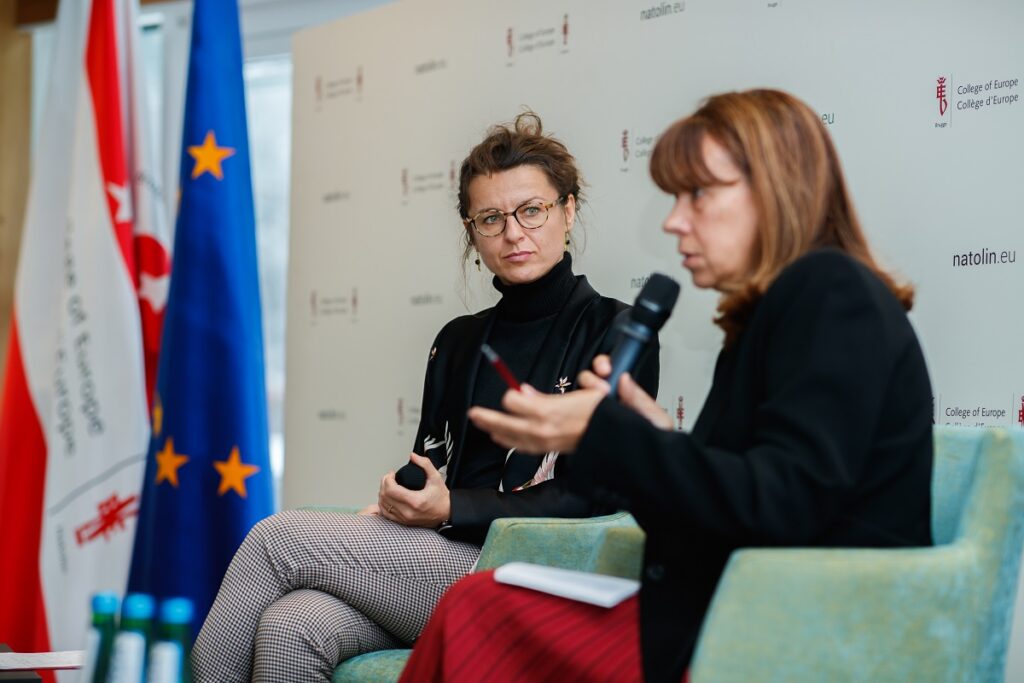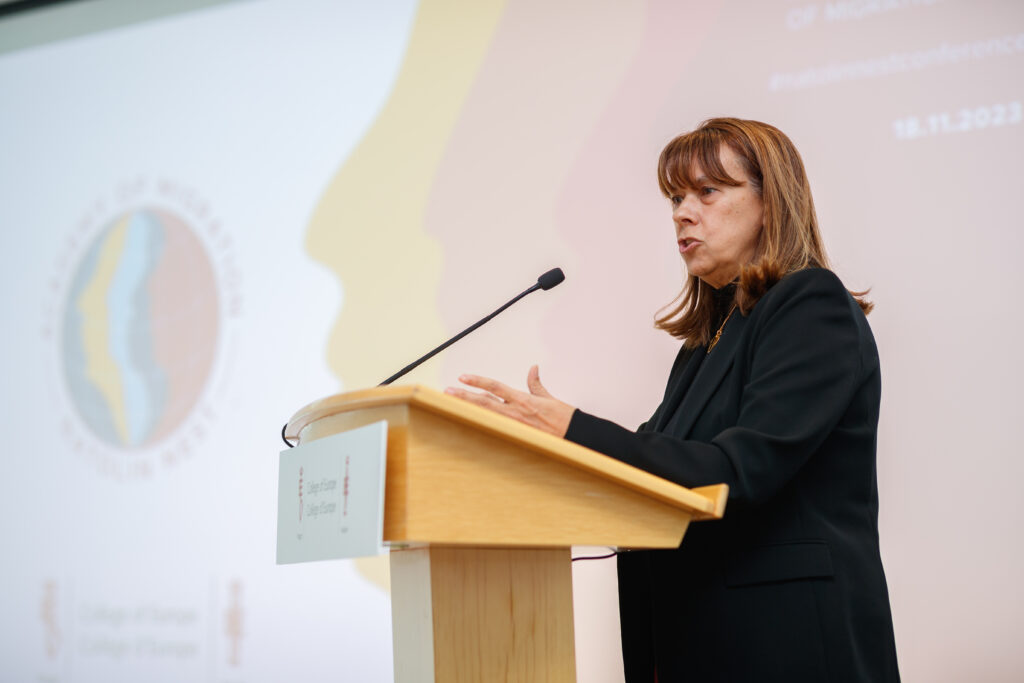On Saturday November 18th 2023, the Migration Nest, led by Patrycja Sasnal and assisted by students from the College of Europe in Natolin, invited a panel of renowned experts from the European institutions and academia to Natolin for the Annual Migration Conference. Although the focus of this year’s conference was “Mediterranean routes of migration to the EU,” it latched on to broader discussions. From different perspectives it dealt with old and new causes as well as possible EU policies and solutions for the contemporary challenges of migration.
Throughout the discussions, it was clear that solutions to the current migration challenges faced by the EU – including those related to migration across the Mediterranean – are incredibly difficult to find. Camino Mortera-Martinez from the Centre for European Reform in fact referred to it as an especially “frustrating policy field”. The reasons, it seemed, are not confined to disagreements between member states or a lack of political will. Rather, solutions are difficult to agree on because different experts simply disagree about what the real “migration problem” is, i.e. how it should be interpreted. Adding disagreements about how concrete facts should be understood to a policy field that has direct and sometimes detrimental consequences for individuals, makes it no wonder that it is a frustrating policy field. However, the conference both shed light on different understandings of the problems and offered some central reflections to consider when moving forward with EU solutions to the “migration” issue connected to the Mediterranean routes as well as in broader terms.
While the snow slowly fell outside the Natolin Winter Garden, a keynote address was given by Ana Cristina Jorge, director of the Operational Response Division of Frontex. It was followed by the first student-moderated panel, where Szymon Pogorzelski, Policy Officer at the DG HOME of the European Commission, partook in a discussion with migration researchers from different institutions. Together, these two speakers provided insights into how contemporary migration problems and solutions are understood by EU institutions. A central problem of migration was emphasized by Jorge as the widespread, dangerous, and illegal migration across the Mediterranean. As she detailed Frontex’s extensive efforts in the area, it became clear that the agency’s work stems from the perception that part of the solution is to identify and distinguish criminals/smugglers, on the one hand, and victims of smuggling on the other. This is done via advanced surveillance technology and on-the-ground operations with the twofold aim to prosecute perpetrators and save and protect victims.

Pogorzelski’s speech revealed two additional contemporary problems of migration facing the EU, namely the EU’s demographic problem, and the challenge of reaching a common European strategy of migration management. To each of these problems, the speaker noted the Commission’s concrete work towards solutions. With an aging population the EU is facing a serious need for workers, and as a potential step towards solving this problem, the Commission discusses opening up certain legal pathways of labor migration to Europe for a specific qualified workforce through so-called talent programs. As a step towards finding a common agreement on migration policy, Pogorzelski mentioned the ongoing discussions surrounding the EU Pact on Migration and Asylum. It should be clarified that this agreement was in fact signed by the European Parliament and the Council shortly after the conference at the end of December 2023.[1]
Where these representatives from Frontex and the Commission were in general agreement about these key problems and the necessary steps towards solving them, they were challenged especially by the researchers of the second panel: Branislav Stanicek from the European Parliamentary Research Service, Camino Mortera-Martinez from the Centre for European Reform, Jolanta Szymanska from the Polish Institute of International Affairs, Alberto-Horst Niedhardt from the European Policy Centre, and Luca Barana from the Istituto Affari Internazionali. Most pointedly, Mortera-Martinez stated that the “crisis of illegal migration” referred to by the previous speakers is not in fact a migration crisis, but a political crisis, since the number of illegal migrants (around 200,000) as well as the link between illegal migration and terrorism tend to be dramatically exaggerated for political purposes. Szymanska agreed that migration is increasingly termed illegal, while Horst-Niedhardt confirmed that the vast majority of migrants in fact arrive legally to the EU (3.5 million vs. 320,000 irregular arrivals in 2021), which brings him to question why such a large emphasis is being put on illegal migration by EU institutions. An alternative answer to this, offered by Mortera-Martinez is that the lack of control of felt by politicians in this political crisis led to an exaggerated need for them to show that action is being taken. And in this process migration is increasingly criminalized.
An additional aspect of the challenge with migration was emphasized in this panel discussion. Although the researchers generally agreed that legal pathways to the EU are needed, they stated this is generally undermined by current attempts by member states and the EU to outsource their migration responsibilities to third countries via bilateral agreements, e.g. via the recent Italy-Albania and EU-Tunesia Memorandums of Understanding. Horst-Niedhardt noted that such agreements are contested in terms of their protection of human rights and that they might even work against the previously mentioned long-term EU labor market needs. Barana linked this recent development in migration agreements to symbolic political actions that aim to show that something is being done rather than constituting effective policy, since such agreements in fact increase the costs and risks of migration and are not especially efficient, especially in the long term.

Finally, the researchers did not share the enthusiasm for the EU Pact on Migration and Asylum, which Horst-Niedhardt referred to, along with other recent EU attempts at solutions, as Kafkaesque reforms that are never evaluated or assessed despite obligations to do so. Szymanska agreed that the pact is not revolutionary and rather, she argued, outsourcing of migration management is no more than the “next phase of the same story.” But not only is the pact of little efficiency, Horst-Niedhardt also expressed his concerns about whether it will in fact allow migrants to access to protection or rather create a sort of “permanent state of exception of sustained irregular migration.” Instead of focusing mainly on deterrence and outsourcing, Szymanska argued, what is really missing from current attempts at EU policy are completely different questions – for example those of integration and visa policy.
In conclusion, these examples from the Annual Migration Conference revealed that fundamental divisions exist, especially between EU institutions and migration experts, when it comes to interpreting problems and solutions for migration. The solutions they deemed relevant fundamentally depended on how they interpret the “problem” and differed dramatically, especially when the problem was considered criminal activity vs. symbolic politics. The discussions also demonstrated that it is not a field of inaction. On the contrary, many potential solutions were proposed, but as Horst-Niedhardt reminded us: We have to consider whether current and future EU policies are addressing the “real” problems or in fact worsening the situation for migrants and EU countries alike.
[1] https://home-affairs.ec.europa.eu/policies/migration-and-asylum/new-pact-migration-and-asylum_en

